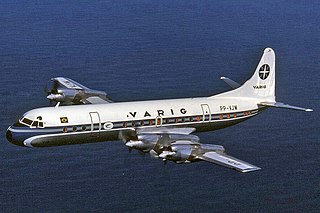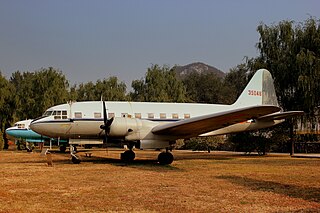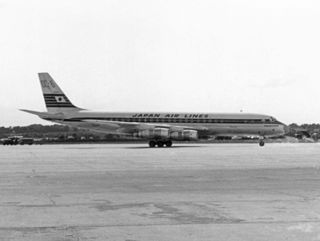
American Airlines Flight 191 was a regularly scheduled domestic passenger flight from O'Hare International Airport in Chicago to Los Angeles International Airport. On the afternoon of May 25, 1979, the McDonnell Douglas DC-10 operating this flight was taking off from runway 32R at O'Hare International when its left engine detached from the wing, causing a loss of control, and the aircraft crashed less than one mile (1.6 km) from the end of the runway. All 258 passengers and 13 crew on board were killed, along with two people on the ground. With 273 fatalities, it is the deadliest aviation accident to have occurred in the United States.

The Lockheed L-188 Electra is an American turboprop airliner built by Lockheed. First flown in 1957, it was the first large turboprop airliner built in the United States. Initial sales were good, but after two fatal crashes that led to expensive modifications to fix a design defect, no more were ordered. With its fairly high power-to-weight ratio, huge propellers and very short wings, large Fowler flaps which significantly increased effective wing area when extended, and four-engined design, the airplane had airfield performance capabilities unmatched by many jet transport aircraft even today—particularly on short runways and high altitude airfields. Jet airliners soon supplanted turboprops for many purposes, and many Electras were modified as freighters. Some Electras are still being used in various roles into the 21st century. The airframe was also used as the basis for the Lockheed P-3 Orion maritime patrol aircraft.

Scandinavian Airlines System Flight 751 was a regularly scheduled Scandinavian Airlines passenger flight from Stockholm, Sweden, to Warsaw, Poland, via Copenhagen, Denmark. On 27 December 1991, a McDonnell Douglas MD-81 operating the flight, registration OY-KHO, piloted by Danish Captain Stefan G. Rasmussen (44) and Swedish first officer Ulf Cedermark (34), both experienced pilots with 8,000 and 3,000 flight hours, respectively, was forced to make an emergency landing in a field near Gottröra, Sweden. Ice had collected on the wings' inner roots before takeoff, broke off, and was ingested into the engines as the aircraft became airborne on takeoff, ultimately disabling both engines. All 129 passengers and crew aboard survived.

Galaxy Airlines Flight 203 was a Lockheed L-188 Electra 4-engine turboprop, registration N5532, operating as a non-scheduled charter flight from Reno, Nevada to Minneapolis/St Paul, which crashed on January 21, 1985, shortly after takeoff. All but one of the 71 on board died.

Oakland County International Airport is a county-owned public-use airport located in Waterford Township, Oakland County, Michigan, United States. The airport is located approximately one mile from the center of Waterford Township and Oakland County. It is included in the Federal Aviation Administration (FAA) National Plan of Integrated Airport Systems for 2017–2021, in which it is categorized as a non primary commercial service facility.

United Air Lines Flight 297 was a scheduled flight from Newark International Airport to Atlanta that crashed 10 miles (16 km) southwest of Baltimore on November 23, 1962, killing all 17 people on board. An investigation concluded that the aircraft, a Vickers Viscount 745D turboprop airliner, had struck at least two whistling swans, which caused severe damage to the plane, resulting in a loss of control.

Trans World Airlines (TWA) Flight 159 was a regularly scheduled passenger flight from New York City to Los Angeles, California, with a stopover in Cincinnati/Northern Kentucky International Airport, Kentucky, that crashed after an aborted takeoff from Cincinnati on November 6, 1967. The Boeing 707 attempted to abort takeoff when the copilot became concerned that the aircraft had collided with a disabled DC-9 on the runway. The aircraft overran the runway, struck an embankment and caught fire. One passenger died as a result of the accident.

Northwest Orient Airlines Flight 706 was a Lockheed L-188 Electra aircraft, registration N137US, which crashed on take-off from Chicago's O'Hare International Airport September 17, 1961. All 37 on board were killed in the accident.

Alliance Air Flight 7412 was a scheduled Indian domestic passenger flight from Calcutta to Delhi, operated by Indian regional airliner Alliance Air. On 17 July 2000, while on approach to its first stopover in Patna, the Boeing 737-2A8 operating the route nose-dived and crashed into a residential area in Patna, killing 60 people including 5 on the ground.

The Ilyushin Il-12 was a Soviet twin-engine cargo aircraft, developed in the mid-1940s for small and medium-haul airline routes and as a military transport.

Mineral Wells Airport is a public airport four miles southeast of Mineral Wells, Texas. The National Plan of Integrated Airport Systems for 2011–2015 called it a general aviation facility. It is owned and operated by the city of Mineral Wells. The airport, and the city, lie in Palo Pinto County and Parker County. The terminal is in Parker County.
Northwest Regional Airport is a privately owned, public use airport 3 nautical miles (5.6 km) northwest of Roanoke, in Denton County, Texas, United States.

Japan Air Lines Flight 446 was a Japan Air Lines flight from Sheremetyevo International Airport of Moscow, Russian SFSR, Soviet Union to Tokyo International Airport in Ōta, Tokyo, Japan.
Several aviation incidents and accidents have occurred in which the control surfaces of an aircraft became disabled, often due to failure of hydraulic systems or the flight control system. Other incidents have occurred where controls were not functioning correctly prior to take-off, either due to maintenance or pilot error, and controls can become inoperative from extreme weather conditions. Aircraft are not designed to be flown in such circumstances; however, a small number of pilots have had some success in flying and landing aircraft with disabled controls.

Sita Air Flight 601 (ST601/STA601) was a Nepalese domestic passenger flight, operated by Sita Air from Tribhuvan International Airport in Nepal's capital Kathmandu to Tenzing-Hillary Airport in Lukla. On 28 September 2012, the Dornier 228 serving the route crashed while attempting an emergency landing at Kathmandu shortly after takeoff, killing all 19 people on board.

On October 30, 2014, a Beechcraft King Air B200 twin turboprop crashed into a building hosting a FlightSafety International (FSI) training center shortly after taking off from Wichita Mid-Continent Airport in Wichita, Kansas. The pilot, the only person on board, was killed along with three people in the building; six more people in the building were injured.

Aeroflot Flight 3739 was a regularly scheduled Russian domestic flight from Irkutsk to Pulkovo Airport in Saint Petersburg that crashed during takeoff from Irkutsk International Airport on 9 February 1976. Twenty-four of the 114 people on board died in the accident.

Air Manila Flight 702 was an unscheduled passenger flight from Naval Air Station Agana in Guam to Ninoy Aquino International Airport in Manila, carrying 33 passengers and 12 crew members; most of whom were personnel from the base. The Lockheed L-188A Electra attempted takeoff from runway 6L but crashed near a residential area; the crash was caused by retracting the flaps at an altitude too low to clear the terrain after the propeller of engine number three feathered. All 45 people on board and one person on the ground perished in the crash. The investigation concluded that the pilot should have followed company policy by aborting takeoff in the event of an engine failure before reaching VR (takeoff) speed.

















